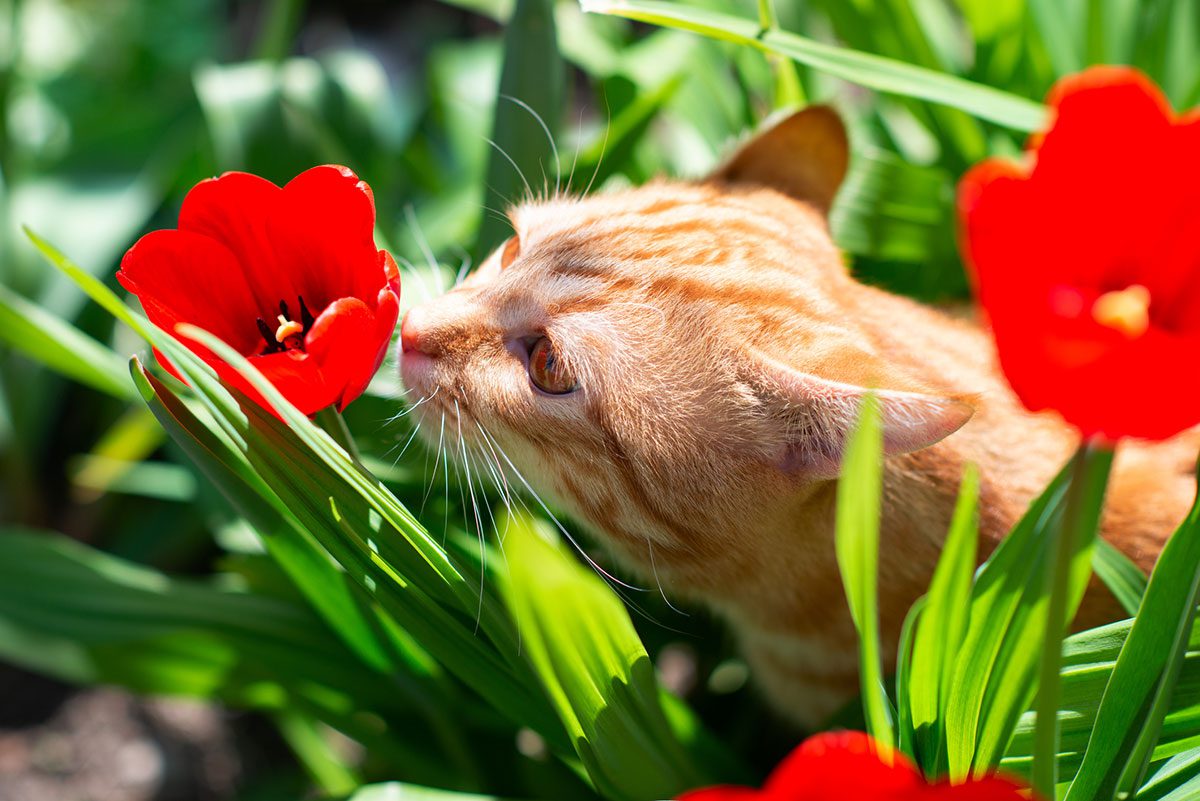Cats are very active and love to explore. Chewing, climbing and hunting are one of the best skills, but it’s difficult to avoid your cat chewing on plants, especially if they are at home or outside your garden. ASPCA listed 417 varieties of plants that are poisonous for cats. It’s shocking to think how our cats can live long and healthy when they are surrounded by plants that are poisonous to them without the owners knowing.

Poisonous Plants to Cats
Many toxic plants can cause inflammation of the skin, mouth and digestive system. They can have a major effect on your cat’s organs, especially the kidney and the heart.
Here are some plants that are toxic to your cats:
Lilies (Lilium sp.)
As beautiful as the plant is, lilies have a bad reputation for being the most dangerous plant for cats. These include Tiger lilies, daylilies, Easter lilies, Asiatic lilies, stargazer lilies, rubrum lilies, western lilies and red lilies.
Lily poisoning causes kidney failure in cats. Every part of the plant is dangerous, the roots, the leaf, the petals and the pollens. Just chewing on two to three petals can cause death. Even just licking pollen or drinking water of the vase the lilies are placed in can cause fatal damage to your cat. Cats are known to consume an amount of pollen just by grooming themselves after rubbing their fur on the plant.
If you suspect your cat being near or licking a lily, contact our Dallas, TX, veterinarians immediately. It’s a situation of life or death. Treatments may include vomiting and intravenous fluid therapy. It is safe to give your cat activated charcoal, which is used as a form of gastrointestinal decontamination.
Azaleas & Rhododendrons (Rhododendron spp.)
Any flower shrub or small trees of Azaleas and Rhododendrons are extremely toxic to the cat’s system. Grayanotoxins is the toxic component of these plants. Any intake of these plants can cause tremors, abnormal heart rate, seizures, vomiting, weakness, coma, transient blindness, and lack of appetite. Fortunately, cats can be removed from this trauma when given veterinary treatment.
Dieffenbachia (Dieffenbachia spp.)
The common houseplant found in homes, hotel lobbies and windows, Dieffenbachia, can also be a killer for cats. It is known as dumb cane, tropic snow, exotica perfection, and it’s part of the Araceae family.
This common plant contains insoluble calcium oxalate crystals. If bitten by a cat, it can cause oral irritation like drooling, vomiting, mouth burning. It also affects a cat’s airway, which makes it difficult to breathe. Although the plant isn’t death threatening, it can still cause extreme pain and discomfort.
Bluebonnets (Lupinus sp.)
Bluebonnets, also known as lupines, are extremely common here in Texas. This beautiful, deep bluish-purple plant is a part of the pea family, and can be found growing in sandy, wide-open fields and on verdant roadsides. The entire plant, including its seeds and pods, is toxic when ingested, especially to ruminants and horses. Bluebonnets are moderately toxic to dogs and cats. Bluebonnet toxicity affects the nervous system, causing lack of coordination, tremors, seizures, agitated behavior, and collapse.
Sago Palm (Cycas revoluta)
Sago Palm is classified in the genera cycas, zamia and macrozamia. They go by many names as coontie palm, cycads, zamias and cardboard palm. These common houseplants are found in tropical areas. All parts of the Sago Palm are toxic, which contains cycasin, the toxic component. The seeds are the deadliest part of the plant and it causes severe liver damages.
Cycasin poisoning can result in gastrointestinal damages, nervous system damages, vomiting, diarrhea, stooling and increase thirst. The Pet Poison Helpline warns that if your cat consumes the Sago Palm, you should rush to the vet immediately. The plant is so dangerous that even cats who are being treated quickly have a 50% chance of surviving the incident.
Autumn Crocus (Colchicum autumnale)
The autumn crocus is also known as naked lady and meadow saffron. It’s a common plant that blooms in the fall and poisonous to dogs, cats and horses. All parts of the Autumn crocus are highly toxic because it contains alkaloid colchicine.
Cats that are near or take the plant have gastrointestinal, vomiting, drooling, diarrhea, breathing difficulties, liver damage, kidney failure seizures or death. If you notice anything abnormal about your cat, visit the vet immediately because symptoms might come shortly after ingestion.
Cyclamen (Cyclamen spp.)
Persian violet and sowbread are a genus of perennial flowers of over 20 species that are often kept in the outdoors. Like every poisonous plant, all the parts of the cyclamen plant are poisonous, especially the tube and the roots. The toxic component is the saponins.
Symptoms you should monitor on your cat are drooling, vomiting, gastrointestinal and diarrhea. Cat parents should not have this plant in their homes, for if consumed in a large quantity, it can cause heart failure and seizures. If you observe these symptoms, it’s best to rush to the hospital immediately.
Amaryllis (Amaryllis spp.)
Amaryllis is the only genus of the Amaryllidinae. It is better known as Jersey lily, belladonna lily, naked lady, and Amarillo. It usually blooms in March. The flower shrub contains phenanthridine alkaloids. All parts of the plant are toxic, but the bulb contains more of the toxic component.
Amaryllis causes vomiting, drooling, seizures, change of blood pressures and tremors. If your cat has been around this plant, take immediate action and visit your veterinary.
Kalanchoe (Kalanchoe spp.)
The houseplant flower is also known as the devil’s backbone, chandelier plant, and mother-of-millions. The parts of the plant have a toxic component called bufadienolides which causes gastrointestinal vomiting, diarrhea, drooling and, if consumed in a large quantity by your cat, it causes seizure, heart arrhythmias, and collapse. These are severe symptoms you should keep an eye on if your cat takes in the plant. You should visit the vet if you notice any of the symptoms occurring in your cat.
Tulip (Tulipa spp.)
Tulips are popular in bouquets for gifts. It is part of the liliaceae family, which includes the deadliest lily species. The toxic component of the plant is tulipalin and tulipalin B. If your cat consumes any part of the plant, especially the bulb causes like drooling, vomiting, tremors, depression and diarrhea will occur.
Safe Plants for Cats
Some plants can be safe for your cat. Here are safe plants listed by the ASPCA:
- Sunflower
- Parlor Palm
- African Violet
- Phalaenopsis Orchid
- Orchids
- Snapdragons
- Spider Plant
- Hens & Chicks Succulents
- Rose
- Zinnia
- Daisies
- Christmas Cactus
- Tillandsia
- Staghorn Fern
Many plants can be dangerous to our fur friends, that’s why it’s important for owners to know what plant is safe for their cats to build a good and safe environment. If you believe your cat has ingested a poisonous flower or plant, please head to our animal hospital immediately!
Recent Posts
About Us
We know that choosing the right veterinarian for your pet (and you) can be a challenge. Yet, with our stress-free handling, our long-term, experienced staff, and a state-of-the-art facility, we make the decision an easy one!
